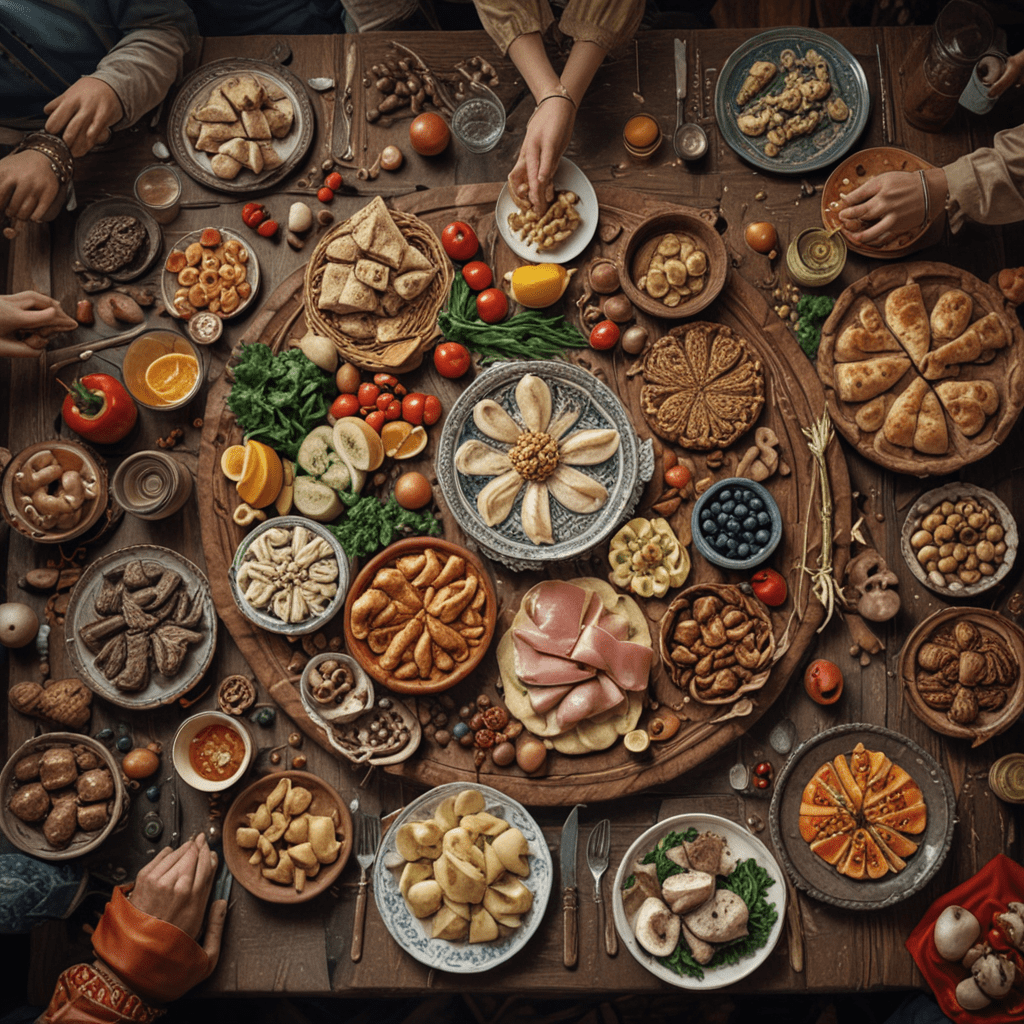1. Slavic Deities and Food Rituals
Slavic mythology is a rich tapestry of beliefs and practices that have had a profound influence on the traditional cuisine of Slavic cultures. Deities played a significant role in food rituals, with each god or goddess associated with specific foods and offerings. For example, Veles, the god of cattle and wealth, was honored with offerings of milk, cheese, and meat. Perun, the god of thunder and lightning, was celebrated with feasts featuring grilled meats and honey mead. These rituals not only nourished the deities but also strengthened the bond between the people and their divine protectors.
2. The Role of Animals in Slavic Cuisine
Animals held a revered place in Slavic mythology, and their symbolism extended to the culinary realm. The bear, considered a sacred creature, was associated with strength and fertility. Bear meat was consumed for its perceived medicinal properties. Wild boar, another revered animal, symbolized courage and determination. Its meat was widely used in Slavic dishes, particularly during festive occasions. Fish, especially sturgeon, played a significant role in Slavic cuisine due to its association with fertility and abundance. Slavs believed that consuming fish would bring good fortune and prosperity.
3. Plant Symbolism and Nutritional Properties
Plants also carried symbolic meanings in Slavic mythology. The oak tree, revered for its strength and longevity, was believed to bestow those qualities upon those who consumed its acorns. Berries, such as strawberries and raspberries, represented love and passion. Their sweetness was thought to attract good spirits and promote fertility. Slavic cuisine incorporated various herbs, flowers, and roots for their culinary and medicinal properties. Dill, parsley, and thyme were commonly used as seasonings and believed to possess healing powers.
4. The Impact of Natural Elements on Food Traditions
Slavic mythology was deeply intertwined with the natural world, and food traditions reflected this connection. The changing seasons influenced the availability and preparation of certain foods. Spring marked the time for fresh vegetables and herbs, while summer was associated with fruits and berries. Autumn brought a harvest of grains, nuts, and mushrooms. The cold winter months necessitated the consumption of preserved foods, such as sauerkraut, pickled vegetables, and smoked meats. Natural phenomena, such as rain and thunderstorms, were believed to affect crop growth and were incorporated into food rituals.
5. The Slavic Calendar and Seasonal Delicacies
The Slavic calendar was divided into various festivals and holidays, each with its unique culinary traditions. Maslenitsa, a weeklong celebration before Lent, featured pancakes, a symbol of the sun and fertility. Kupala Night, a summer festival honoring the sun, was marked by the consumption of cheese, herbs, and berries. During harvest time, a variety of pastries, such as pirozhki and kurnik, were prepared to express gratitude for the bounty of the earth. These seasonal delicacies were an integral part of Slavic culture, connecting people to the rhythms of nature and their ancient beliefs.
6. Traditional Slavic Cooking Methods and Techniques
Traditional Slavic cooking methods and techniques have been passed down through generations, preserving the flavors and traditions of the past. Slavs favored simple yet effective cooking methods that enhanced the natural flavors of their ingredients. Roasting, grilling, and stewing were common techniques, particularly for meats and vegetables. Baking was widely used for breads, pastries, and sweet treats. Slavic cuisine also incorporated fermentation and pickling to preserve food during the long winter months. Sauerkraut, a fermented cabbage dish, and pickled vegetables were staples of the Slavic diet, providing essential vitamins and nutrients.
7. Slavic Myths and Legends about Food
Slavic mythology is replete with stories, myths, and legends that revolve around food. The tale of Baba Yaga, the witch who lives in a forest hut, features magical food that can heal the sick and grant wishes. In another myth, the thunder god Perun created mead from honey and water, a beverage that became a symbol of Slavic hospitality and celebration. Legends about sacred animals, such as the bear and the wild boar, often intertwined with food traditions, imbuing them with symbolic and ritualistic significance.
8. Slavic Festivals and Feasting Customs
Slavic festivals and holidays were marked by elaborate feasts and traditional dishes. Maslenitsa, a pre-Lenten celebration, featured pancakes as a symbol of the sun and fertility. Kupala Night, a summer festival, was celebrated with bonfires, dancing, and the consumption of cheese, herbs, and berries. Harvest festivals, such as Obzhinky, were occasions for feasting and gratitude for the bounty of the earth. Traditional Slavic cuisine played a central role in these celebrations, fostering a sense of community and honoring the rhythms of the natural world.
9. The Influence of Slavic Mythology on Modern Cuisine
The influence of Slavic mythology on traditional cuisine continues to reverberate in modern cooking. Slavic flavors, ingredients, and cooking techniques are still prevalent in many Eastern European dishes. Sauerkraut, dumplings, pirozhki, and other traditional fare have become beloved by people worldwide. Contemporary chefs are also drawing inspiration from Slavic mythology, incorporating ancient symbols and stories into their creations. The enduring legacy of Slavic mythology in food culture adds depth and richness to the culinary landscape, connecting us to our ancestors and the traditions of the past.
10. Conclusion: The Enduring Legacy of Slavic Mythology in Food Culture
Slavic mythology has profoundly shaped the traditional cuisine of Slavic cultures. From the reverence for deities and animals to the symbolism of plants and the impact of natural elements, Slavic beliefs and practices have left an indelible mark on the culinary landscape. Traditional cooking methods, myths, legends, and festivals have perpetuated these influences, fostering a sense of identity and connection to the past. Even today, Slavic mythology continues to inspire and influence modern cuisine, ensuring that the flavors and traditions of the ancient Slavs will endure for generations to come.
FAQ
Q: How did Slavic mythology influence the use of certain ingredients in Slavic cuisine?
A: Slavic mythology attributed symbolic meanings to plants and animals, influencing the use of certain ingredients in Slavic cuisine. For example, the bear, considered a sacred creature, was associated with strength and fertility, leading to the consumption of bear meat for its perceived medicinal properties.
Q: What role did Slavic festivals play in shaping Slavic cuisine?
A: Slavic festivals were marked by elaborate feasts and traditional dishes. These feasts often featured foods associated with the occasion, such as pancakes during Maslenitsa, a pre-Lenten celebration, and cheese, herbs, and berries during Kupala Night, a summer festival.
Q: How is Slavic mythology still relevant in modern cuisine?
A: The influence of Slavic mythology on Slavic cuisine is still evident in modern cooking. Slavic flavors, ingredients, and cooking techniques are prevalent in many Eastern European dishes. Contemporary chefs also draw inspiration from Slavic mythology, incorporating ancient symbols and stories into their creations, ensuring that the flavors and traditions of the ancient Slavs continue to inspire and influence modern cuisine.


